A bug-costumed superhero soars through the cosmos, accompanied by insectoid minions and a curious piece of technology. Is it a scene from the next Avengers movie?
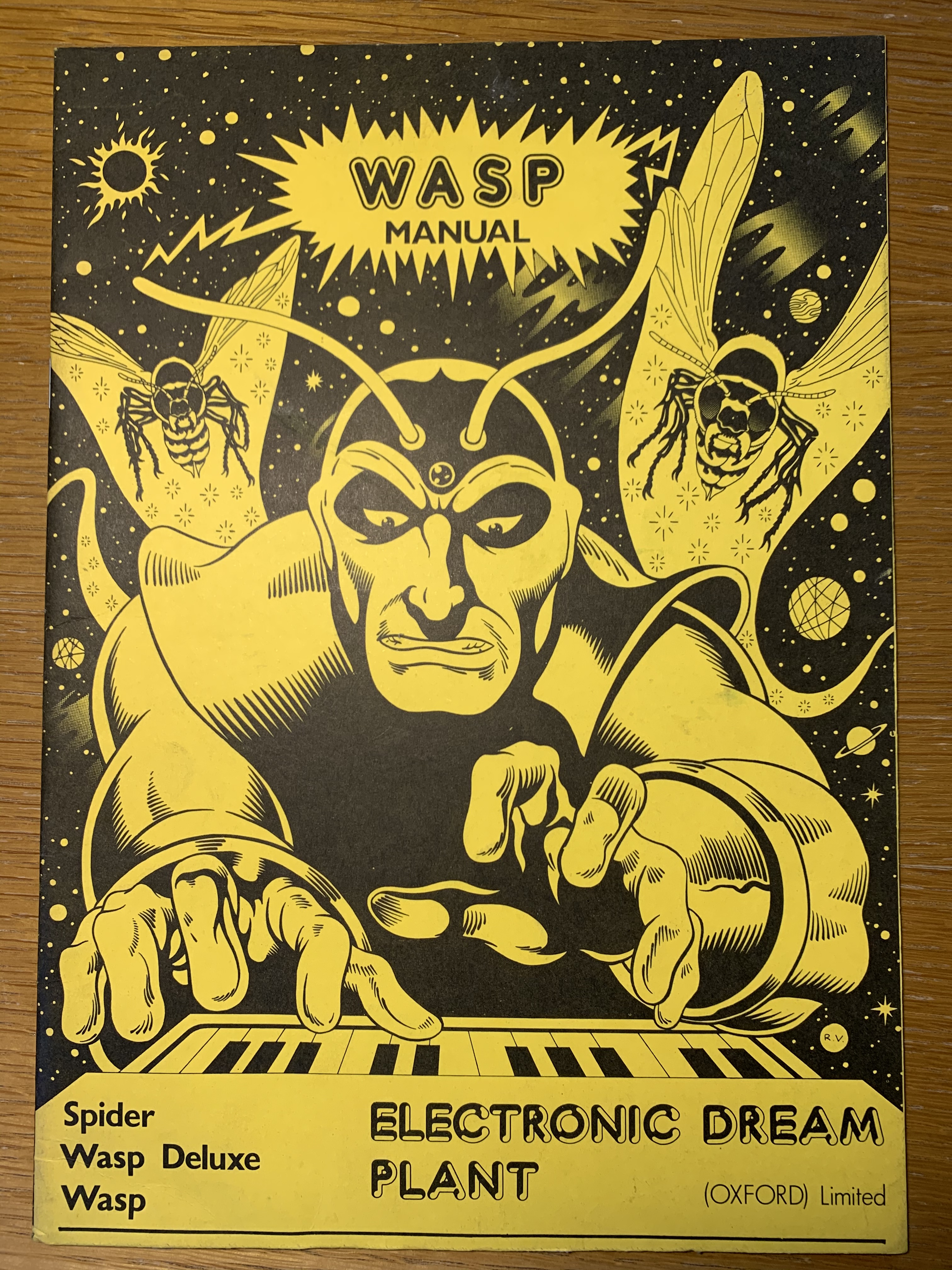
No, it's just an ad for the Wasp synthesizer, a characteristically quirky product of late-'70s/early-'80s UK upstarts Electronic Dream Plant (EDP), mavericks who empowered countless post-punk and synth-pop bands by going against the grain with their offbeat equipment.
EDP made cheap, plastic instruments that were anything but toys. And the bug-themed branding that encompassed everything from their advertisements to their nomenclature (Wasp, Gnat, Spider, Caterpillar) was the least of the company's idiosyncrasies.
Formed in 1977 during the heyday of punk, EDP seemed to embrace the era's scrappy, DIY ethic. They subverted both technological and corporate conventions to make instruments targeted to working-class musicians, with a plan to put synth power in the hands of the people.
The Dream Team
The company was founded by the odd couple of Adrian Wagner and Chris Huggett. The great-great grandson of legendary composer Richard Wagner, Adrian was a headstrong electronic musician who'd already released several albums that ranged from Tangerine Dream-like cosmic excursions to tracks that seemed to predict the New Wave years in advance. Huggett was a visionary boffin who'd been working with tape machines as an engineer/technician for 3M.
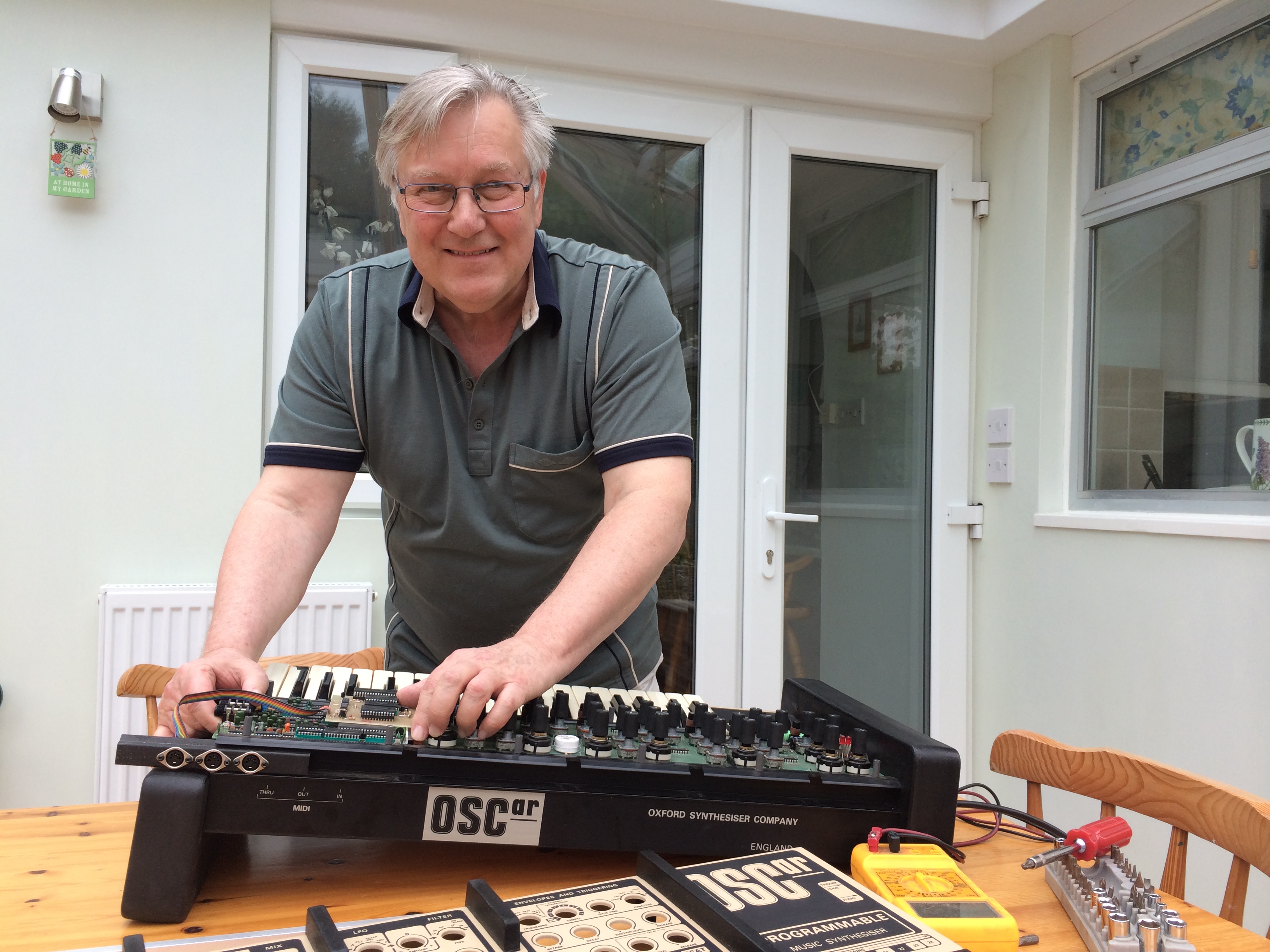
They met when Wagner was working on a project with 3M. Wagner shared with Huggett his idea of building an inexpensive mass-market synthesizer.
At this point, there were still relatively few synth manufacturers, and even the cheapest monophonic instruments were beyond most blue-collar budgets, especially for young people.
In the studio, synths were exotic beasts that required the assistance of outside programmers. In performance, they were unwieldy, sometimes unstable, and far too costly and delicate to be banged around in the back of your big brother's cargo van.
Anthony Harrison-Griffin, an engineer who would become a key element in the EDP mix a bit later, picks up the story. "That [idea] burned away at Chris for quite a while. And then Chris phoned Adrian back up and said, 'I think I've got something for you.'" Huggett's eureka moment came in the form of using integrated circuits for what would become the Wasp.
Birth of the Wasp
"Chris used integrated digital electronics where fundamentally other systems were analog," explains Harrison-Griffin. "If you look at the circuit board on a Wasp, it's got chips everywhere. They're all integrated chips which are generating digital signals. That allowed him to put that through digital oscillators. That was really a game changer. Nobody had really grasped integrated digital circuitry in the way that Chris had for this type of product."
That and cost considerations led to the creation of a flat, touch-sensitive panel with a keyboard graphic overlaid in lieu of actual keys. It was partly inspired by the similar touchpad found on the Stylophone (most famously heard on David Bowie's "Space Oddity"). The ability to slide straight across the "keyboard" created possibilities unavailable on most other synths.
That wasn't the only revolutionary aspect of the Wasp's circuitry. "There wasn't enough room on the circuit board," explains Harrison-Griffin, "so double-sided circuit boards had to be used. It was used in computers but I think the double-sided circuit board had never been used in a synthesizer at that stage."
True to the renegade spirit that would define EDP, there was nothing formal about the birth of the Wasp. "It wasn't 'designed,' says Harrison-Griffin, "it just literally came out of a series of conversations. It was all designed on the back of a fag [cigarette] packet, really. No drawings, nothing! 'We'll just plug it in there.' The only drawing that was ever done was Chris's of the circuitry."
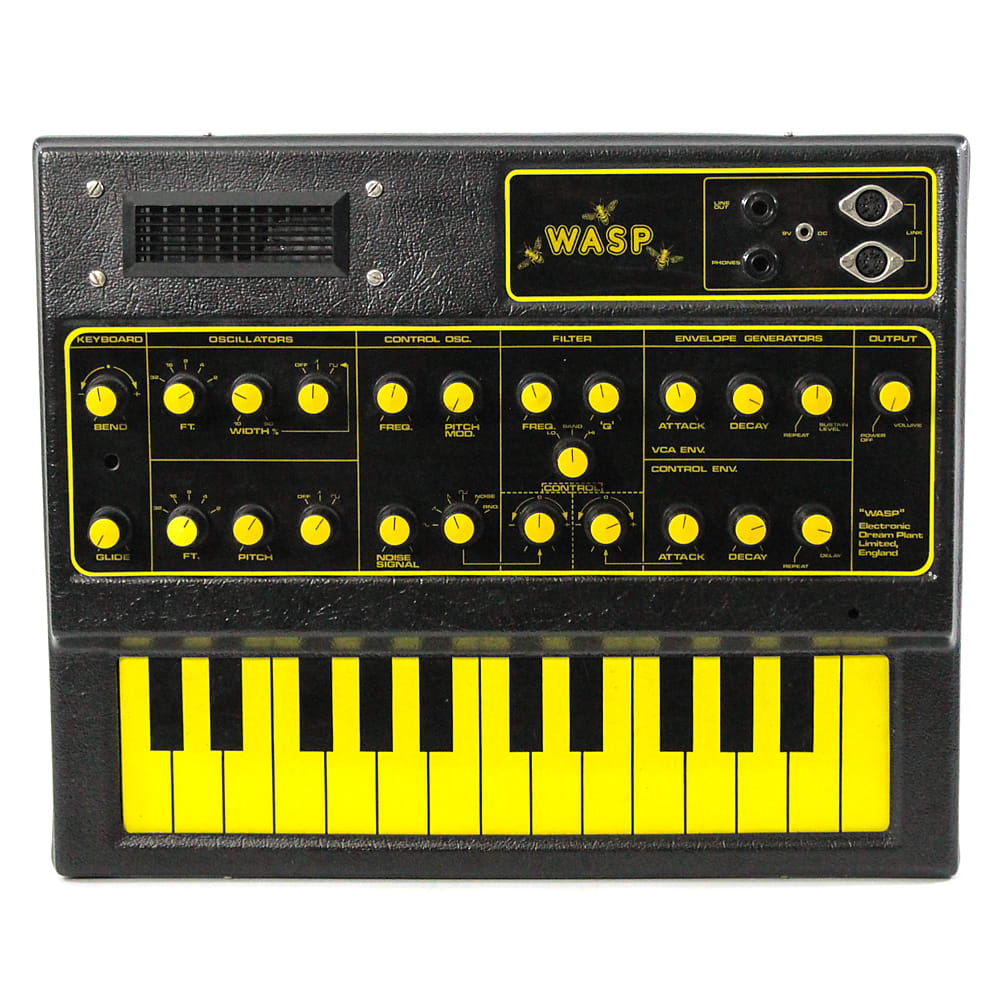
Huggett used his engineering skills to create the planform, while Wagner determined the layout. They gave the simple, monophonic Wasp two digital oscillators, analog envelope and filter controls, and a sturdy but relatively lightweight plastic housing with a black-and-yellow color scheme befitting its namesake.
"The key part was the price," says Harrison-Griffin. "Adrian really wanted to hit the £200 mark." Since the most affordable alternative at that time would have been something like an ARP Odyssey, which he reckons went for £700-800 back then, the impact would be enormous.
Hello World
The Wasp met the world in 1978, hitting all the marks Wagner and Huggett had laid out for it—affordability, mobility (it even had a built-in speaker if you wanted to use it sans amplifier), and reliability. The digital oscillators helped greatly with that last one, says Harrison-Griffin. "The nightmare of the analog system was that you had to tune it every half hour. Whereas once you've got this thing in digital format that was it. It's made up of zeros and ones and it's either on or it's off."
But just as Wagner had presumed, the Wasp's biggest selling point was the price. Budget-bound musicians hungry to make electronic sounds ran towards the instrument as if they were magnetized and its hull was steel instead of plastic.
In an interview with Red Bull Music Academy, synth-pop pioneer Thomas Leer remembered, "I was looking at ARP Odysseys and Minimoogs, but I was broke, so the Wasp was the only option for me... The sound was instant and powerful, they had it hooked up to a Peavey amp, and it just blasted through the shop. I was like, 'This is the one for me!', and bought it on the spot."

The synth lines on Leer's milestone 1979 debut LP, The Bridge, were all done on the Wasp. "The Wasp was like a punk rock synthesizer," he says, "because it was cheap and nasty and it did the job—and that allowed people who couldn't afford a Korg or whatever to get on with it."
In the same story, Chris Carter of post-punk/industrial innovators Throbbing Gristle recalled, "It was pretty different to most keyboard synths on the market. The plastic case, the keyboard and the size had echoes of the EMS Synthi AKS keyboard, but the color scheme and the layout were very different. Then I saw the low price and high specification, and realized this little synth was going to be a serious game-changer for a lot of struggling electronic musicians."
Another 1979 debut album featuring the Wasp as its only synth was Product Perfect by post-punk outfit Fashion (aka Fàshiön Music). Frontman Luke James recalls:
"The Wasp was really the first affordable synth available in Birmingham music shops in 1978. I remember [Fashion bassist/keyboardist John] Mulligan got one of the first ones. Soon after, Nick Rhodes of Duran Duran got one. Fàshiön were a big influence on the formation of Duran Duran... with Mulligan and Nick comparing and sharing sounds they came up with on their Wasps. For what it was it had a remarkable range of sounds and possibilities. It definitely helped shape Fàshiön's sound."
The Wasp was the first instrument Rhodes ever purchased. Many years later, he enthused in Keyboard Magazine, "It doesn't sound like anything else. It really does have a unique character to it."
In between the end of Dave Stewart and Annie Lennox's band The Tourists and the start of Eurythmics, Stewart found inspiration for the first flowerings of the latter by working with the Wasp. "I could actually get some interesting things happening," he told Sound on Sound, "sequenced little sort of random hold patterns that sounded very exciting to us, even though it was just coming out of the plastic speaker."
The instrument's sphere of influence even extended to the other side of the pond. Devo's Gerald Casale told Tape Op, "We loved the sound of the Wasp and we were so excited about the Wasp that, in a suicide move, we used them onstage during the Duty Now for the Future tour. As soon as any drip of sweat from my head or hands hit this thing, it'd go "Bleewwwdawablawdwa!" I wouldn't be touching it, and it would be playing."
Bigger Dreams, Smaller Synths
The Wasp made EDP unexpected players in the synth scene. But in January 1980, the arrival of an enthusiastic industrial design student would soon find the company doubling down on its mission of making synths everybody could afford.
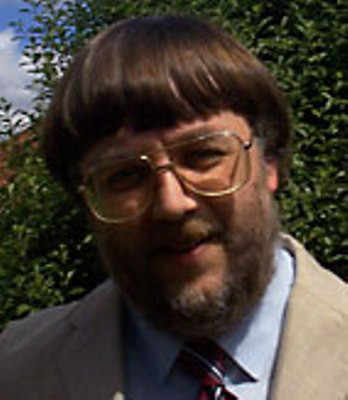
Anthony Harrison-Griffin was a proud Wasp owner in his second year studying product design at London's Central School of Art & Design when he contacted Wagner about completing his degree by embedding himself at EDP and writing a painstakingly detailed report on the construction of the Wasp. All the company's operations were out of the Red Gables house in Oxford where Wagner lived and had his recording studio.
"I headed off into the Oxfordshire countryside to this strange, sort of '50s house in the middle of nowhere," Harrison-Griffin remembers. "EDP was certainly a fairly hedonistic place by the time I walked in the door. There was lots of drugs and rock 'n' roll at the time and that's what was going on. It was a fairly crazy place. The whole of the ground floor was basically the production of EDP with the studio. The upstairs of Red Gables was just living accommodation. That was where Adrian and Kathy, his wife, lived. There were very blurred edges between what went on in EDP's business world and what went on in the private world."
The new kid quickly went from spectator to participant, drafted into the team tasked with creating an even more stripped-down synth that could sell for half the price of the Wasp. In keeping with EDP's buggy branding it would be known as the Gnat. "I built a prototype of the Gnat once I'd designed it," recalls Harrison-Griffin. "Adrian took it to the banks in London to gain the finances to actually invest in the tooling to make it."
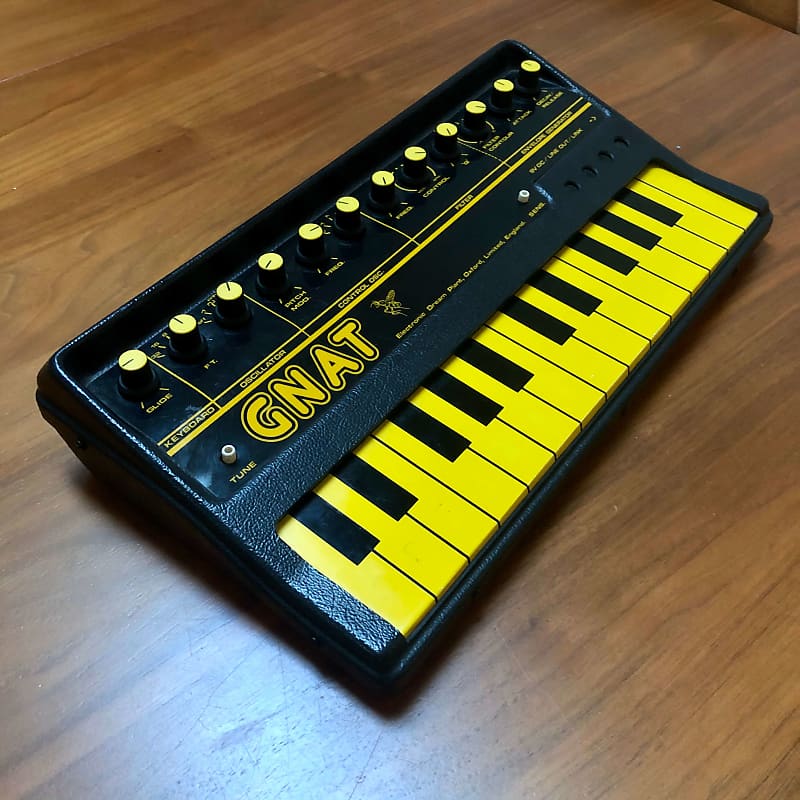
He remembers getting a classic good news/bad news call from Wagner. "He said, 'Well we've got the funding!' He said, 'We haven't got quite as much funding as we wanted.' [I asked], 'So is that the bad news?' He said, 'No. The bad news is I've dropped your prototype on the [train] platform and it's in bits.'"
Even while stripping things down, Harrison-Griffin tried to craft a more tactile keyboard for the Gnat. "I came up with a design they fell in love with," he explains, "to turn it more three-dimensional. Instead of the keyboard just being a cut-out area, it actually has a front edge. It emulates a little bit of a normal keyboard." The Gnat had one oscillator to the Wasp's two, so it was slightly smaller, and the filter was digital instead of analog. "it doesn't even have an on/off button," says Harrison-Griffin. "There's no volume control either. It was stripped to the bare basics."
Retailing for just under £100 when it hit the market in 1981, the Gnat generated an even bigger buzz than its older sibling. "As soon as the Gnat came out people suddenly thought, 'I don't need to wait for a Wasp.' We had an immediate problem… we just couldn't make it fast enough. You plug a Gnat into a decent amp and you get some phenomenal stuff out of it. Some of the low-end stuff is phenomenal, it reminds me a little bit of the Minimoog Model D. Some of the filters on there are exceptionally good."
Expanding the Hive
The Wasp and the Gnat were the major pegs on which EDP hung its hat, but during the company's brief, bold run, other ideas were realized that expanded the capabilities of those instruments.
In between the arrival of the Wasp and the birth of the Gnat, Electronic Dream Plant premiered the Spider, a simple but surprisingly effective sequencer to be used in tandem with the Wasp. "You put those things together and you've got some marvelous capabilities straight away," enthuses Harrison-Griffin. "The Spider literally was like taking the casing of the Wasp and slicing a bit off it, so they sit beautifully next to each other. It's pretty seamless."
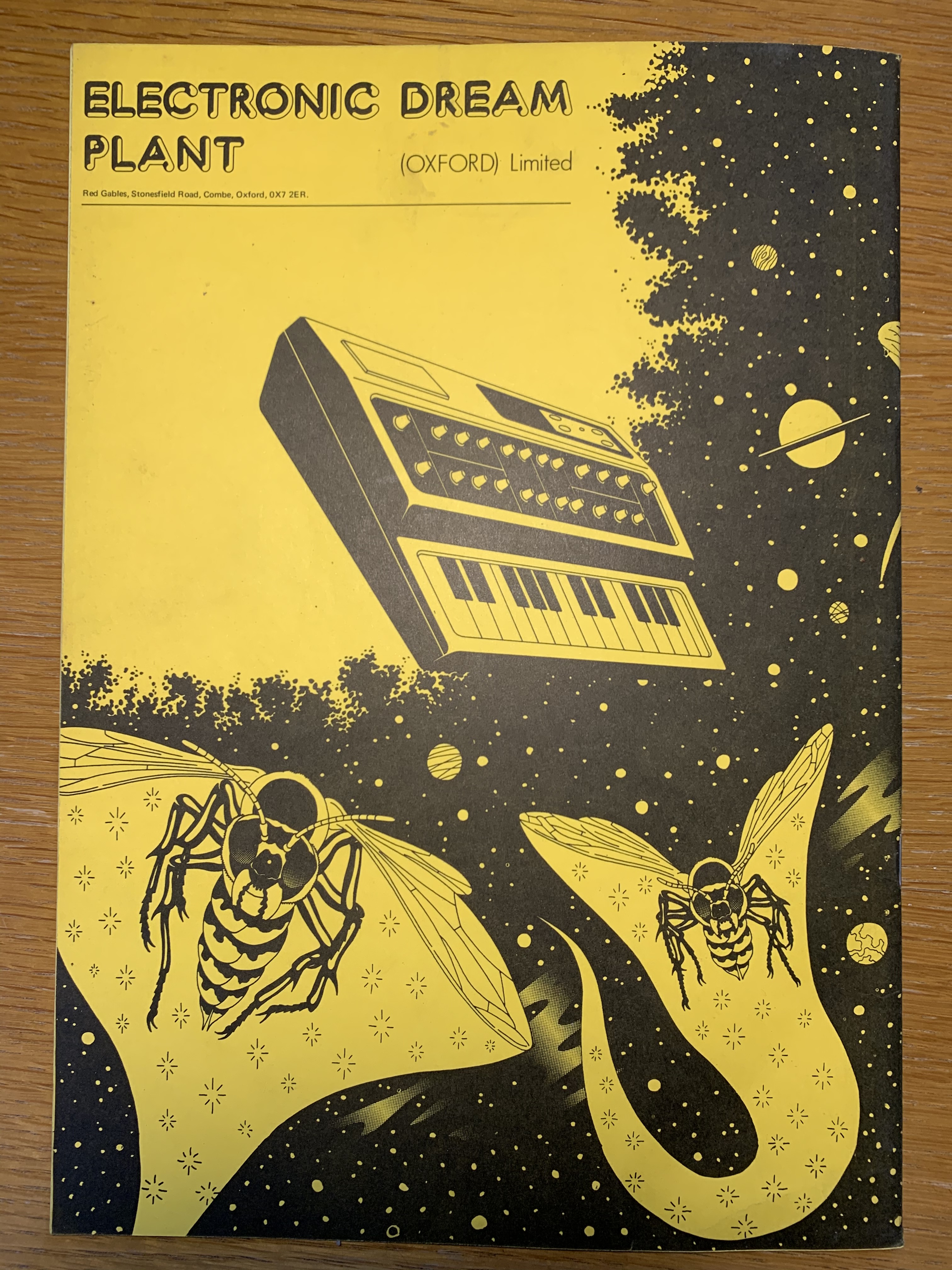
The Caterpillar was designed for those who couldn't deal with a touchpad and demanded a real-deal keyboard. MIDI technology was years away but the Caterpillar functioned similarly to a MIDI keyboard controller. "That was a game changer because it allowed you to plug four Wasps into one keyboard," says Harrison-Griffin, "which allowed you to have polyphony for a fraction of the price. Each Wasp had two-key capability, so you have four Wasps, you've got an eight-key capability. That was pretty mind-blowing at the time for the money."
For those accustomed to conventional keys there was also the Wasp Deluxe, the closest EDP ever came to a conventional keyboard synth. It was basically a tricked-out Wasp with wooden housing and a real, three-octave keyboard.
After Huggett and Wagner parted ways (more on that in a minute), Wagner put out a couple of last-gasp Wasp and Gnat Specials, sort of a half-step between the original synths and the Deluxe treatment, with a wooden case but a touchpad keyboard. "They were never very successful," says Harrison-Griffin. "I think Adrian decided to produce them in these ways and string it out a bit."
Aftermath and OSCar
After a couple of years of Wasps and Gnats flying around, Wagner and Huggett found themselves at cross purposes. "Chris wanted to move the business away from the image," Harrison-Griffin explains, "he never really liked the look of the Wasp or the Gnat. He then had meetings with Adrian along the lines of, 'Can we do something completely different in parallel? We'll carry on doing Wasps and Gnats and Spiders and all of those. In tandem to that can we develop other stuff that is more professional-looking?' I think Adrian just flatly refused. All he wanted to do was expand the business they currently had. It just got more argumentative."
In 1982 the conflicts came to a head as Wagner and Huggett divided up the company between them. "Adrian didn't then actually honor dissolving EDP," remembers Harrison-Griffin, "he carried on trading as EDP until his [manufacturing] stock was out. He did some of these emulations [e.g. the Specials] with the idea that it would perhaps produce more revenue with the bits that he had available."
Freed from the insect realm, Huggett started fresh by founding the Oxford Synthesiser Company. Though the venture was short-lived, its one product deserves a story of its own. With the aid of Harrison-Griffin, he created the OSCar, a mono synth that debuted in 1983 with two oscillators and a unique, rubbery element that both acted as a protective cushion and gave the instrument an unprecedented profile.
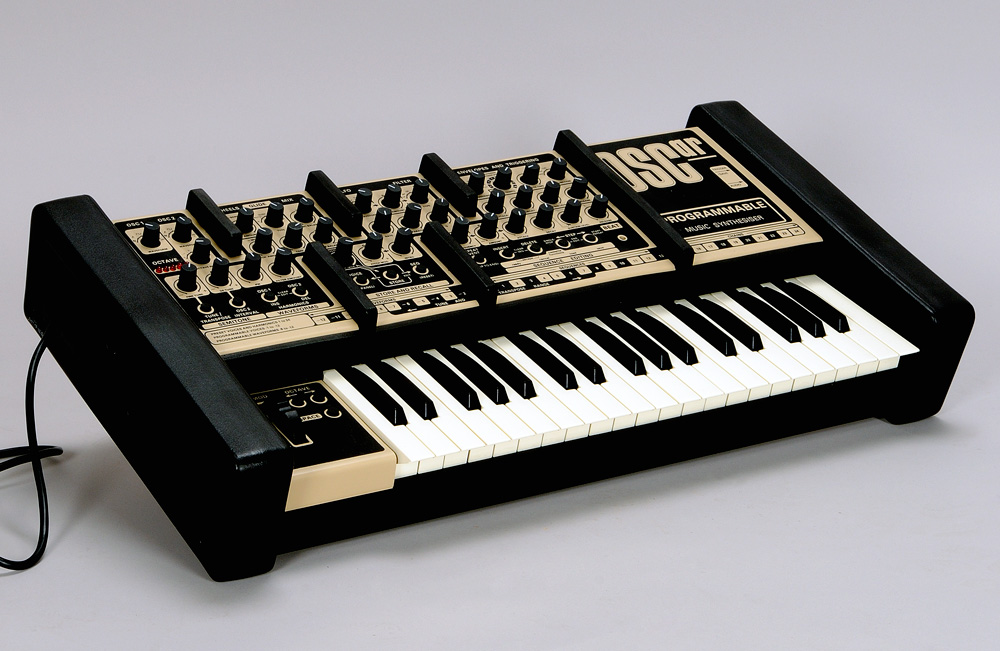
"By the time we got together on the OSCar we had really debugged the issues that were problems on the Gnat and the Wasp," says Harrison-Griffin. I was responsible for a fairly avant-garde look which is a love/hate situation. I approached it from the point of view of practicality, that literally you could take this thing and throw it in the back of your touring van and you wouldn't have to put it in a flight case. I spoke a lot with Billy Currie of Ultravox, who took it on tour for about nine months and it came back pretty much as it left, which was pretty impressive."
One of the most remarkable aspects of the OSCar was its MIDI capability, rare at the time except on the most expensive synths. The OSCar was ultimately embraced by everybody from Keith Emerson to Stevie Wonder.
The instrument was built in Huggett's home workspace, remembered by Harrison-Griffin as a gloriously geeky sort of hobbit den. "You climbed through a really small hole to get into it, and there's benches all the way down and no natural light. That was his heaven. It was like he was cocooned in this world. He climbed through this hole and transcended into a different place."
Living Legacy
Not long after the OSCar's arrival, Huggett went to work for Novation, where he'd remain until his death in October 2020. Wagner passed away two years earlier. But the instruments they designed never lost their appeal or their influence.
Today you can find reboots like a modular version of the Wasp and a software version of the OSCar by other companies. But Electronic Dream Plant obsessives still search for exceedingly rare vintage Wasps and Gnats to incorporate into their work.
As collectors' items, the old EDP instruments are no longer for budget-minded newbies. But they still look and sound like nothing else. "It was the clashing of those two minds, Adrian and Chris, that made this all happen," says Harrison-Griffin. Lamenting Huggett's passing, the iconic composer Hans Zimmer called him "A hugely influential designer." Phil Hartnoll of Orbital declared Huggett "a bit of a British synth hero to us in the know."
The dreams made real decades ago by the EDP crew seem impossible to forget. And that's probably just the way Huggett and Wagner would have wanted it.
